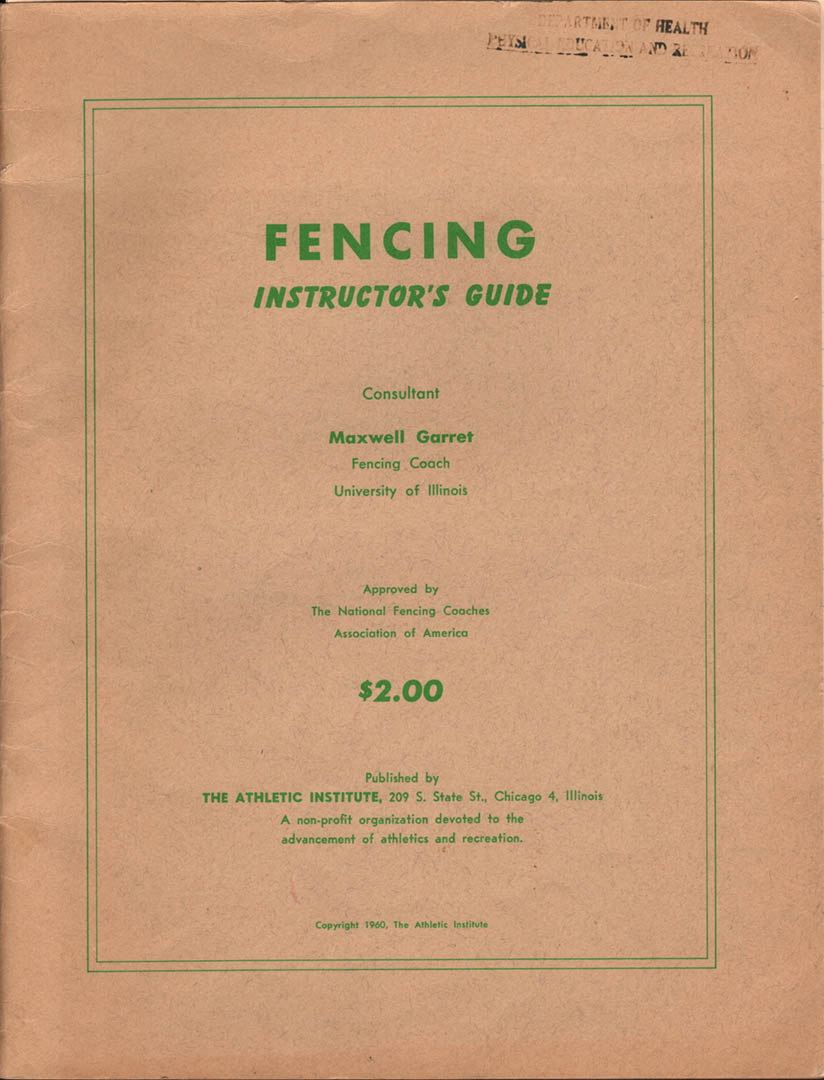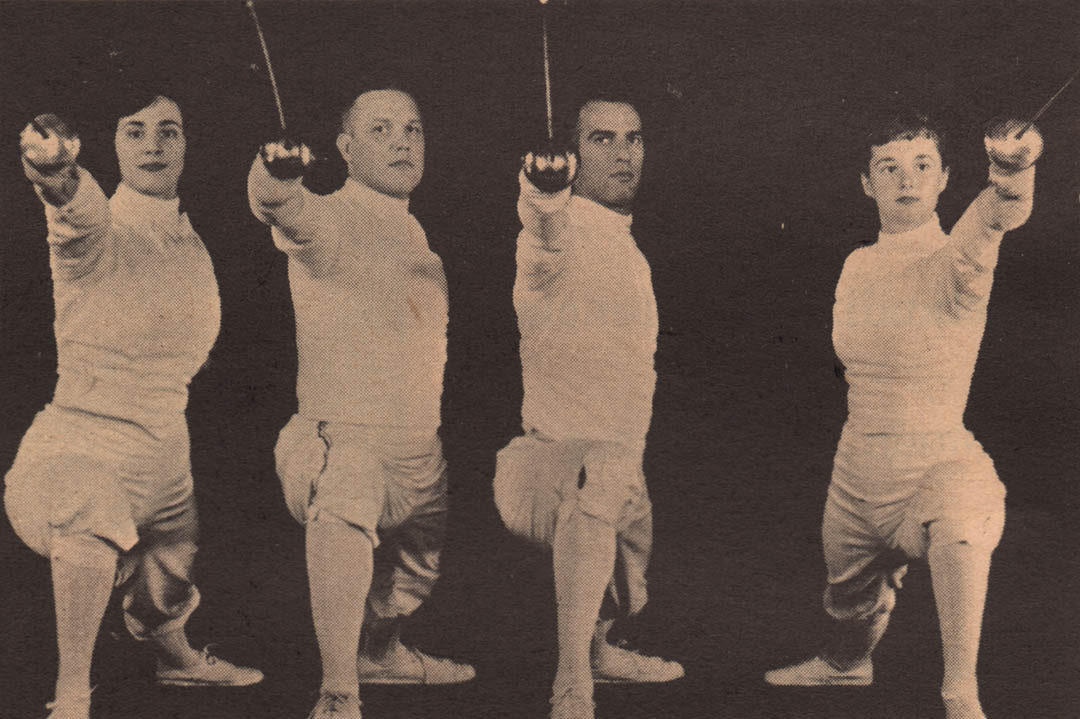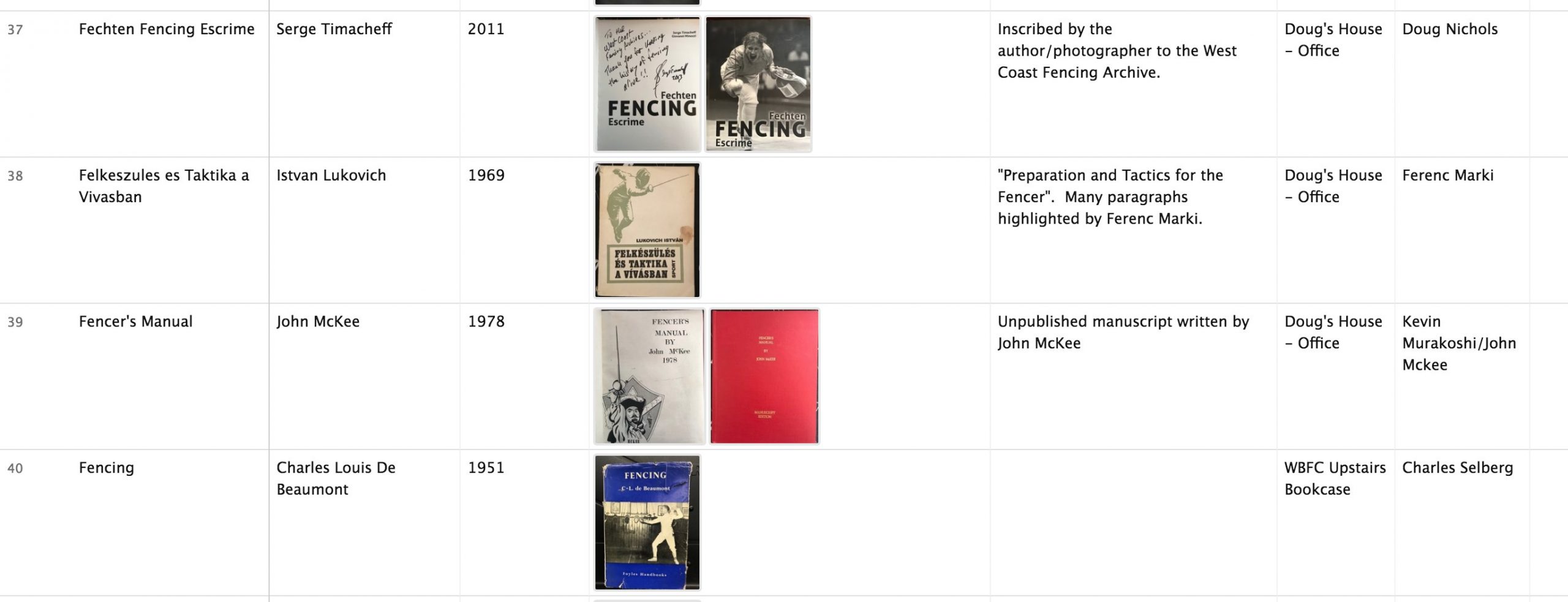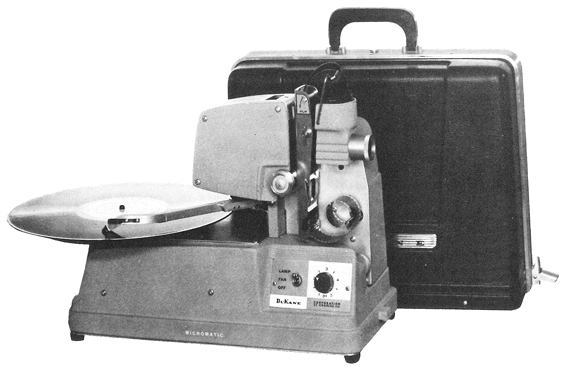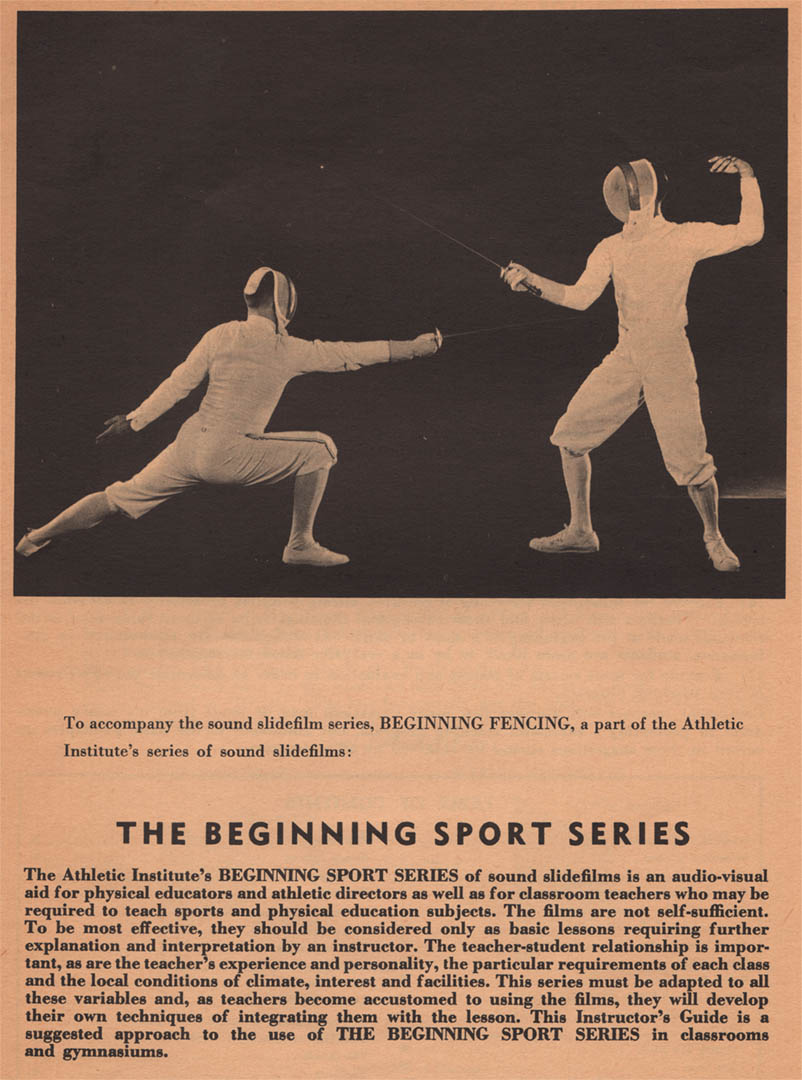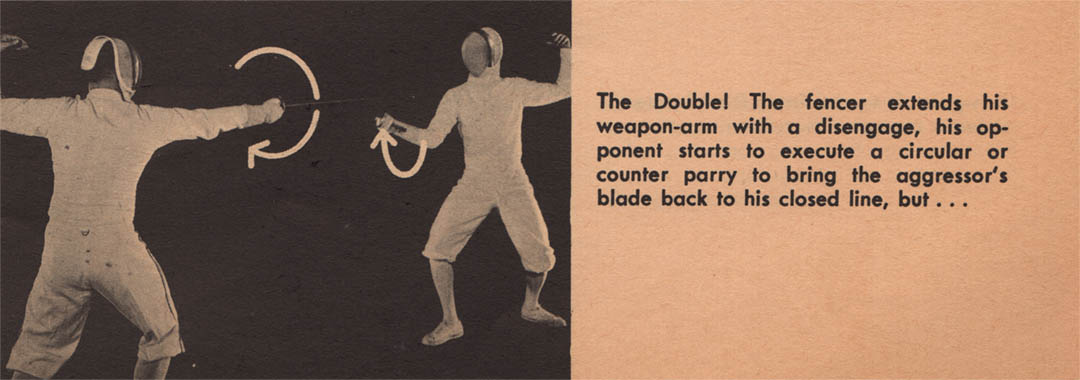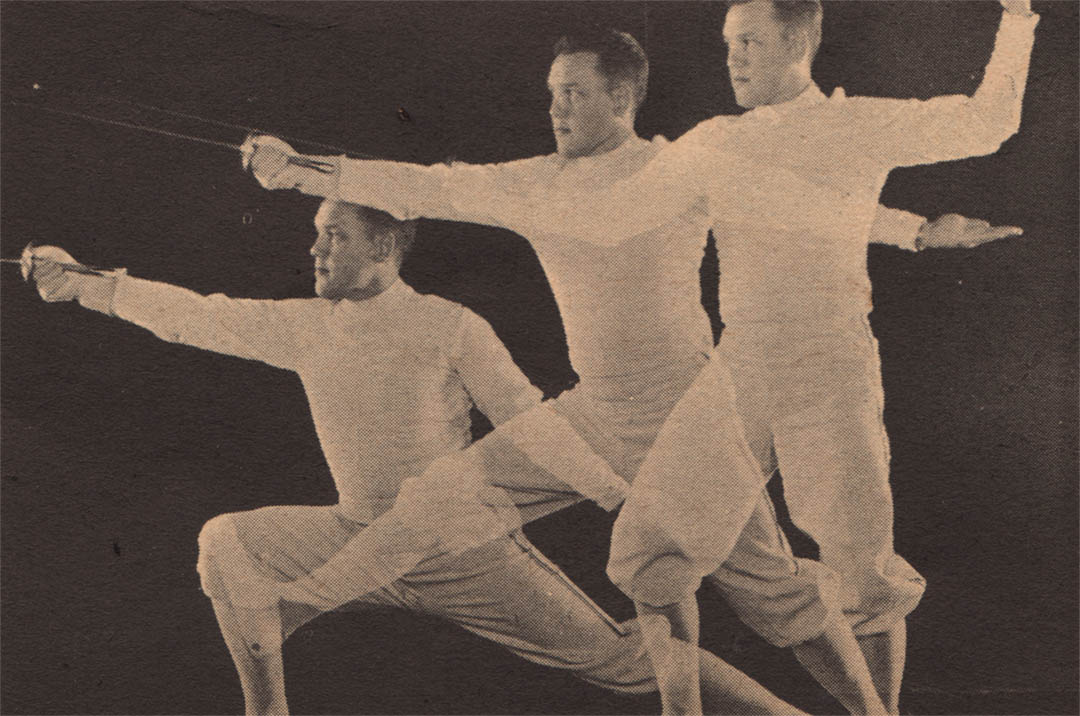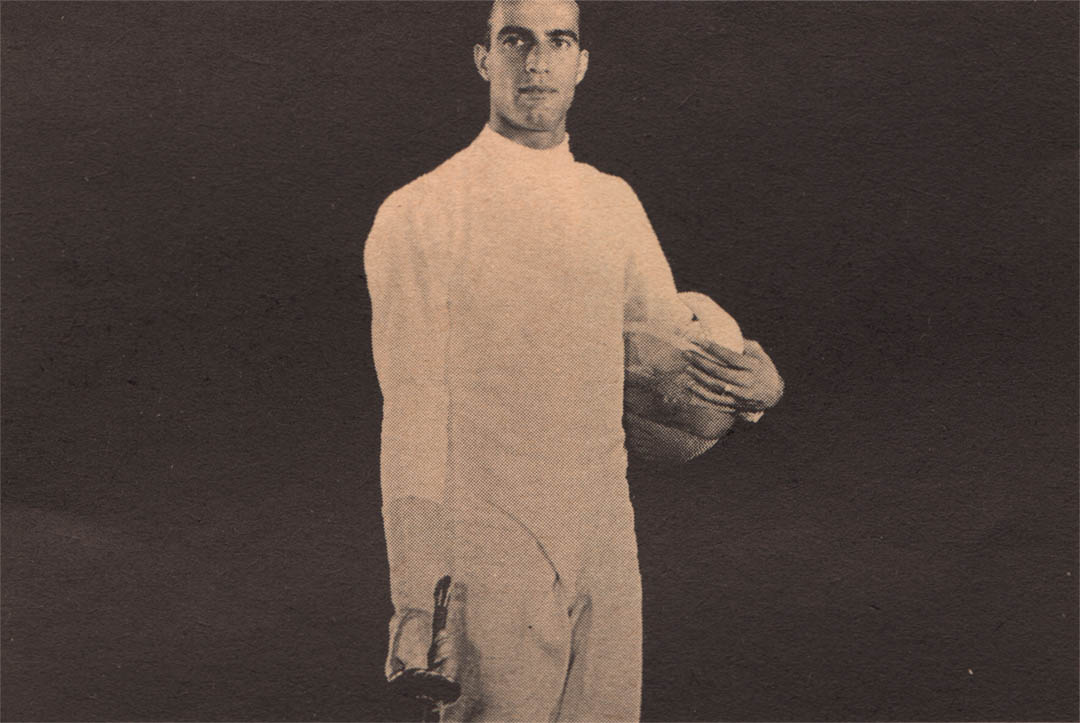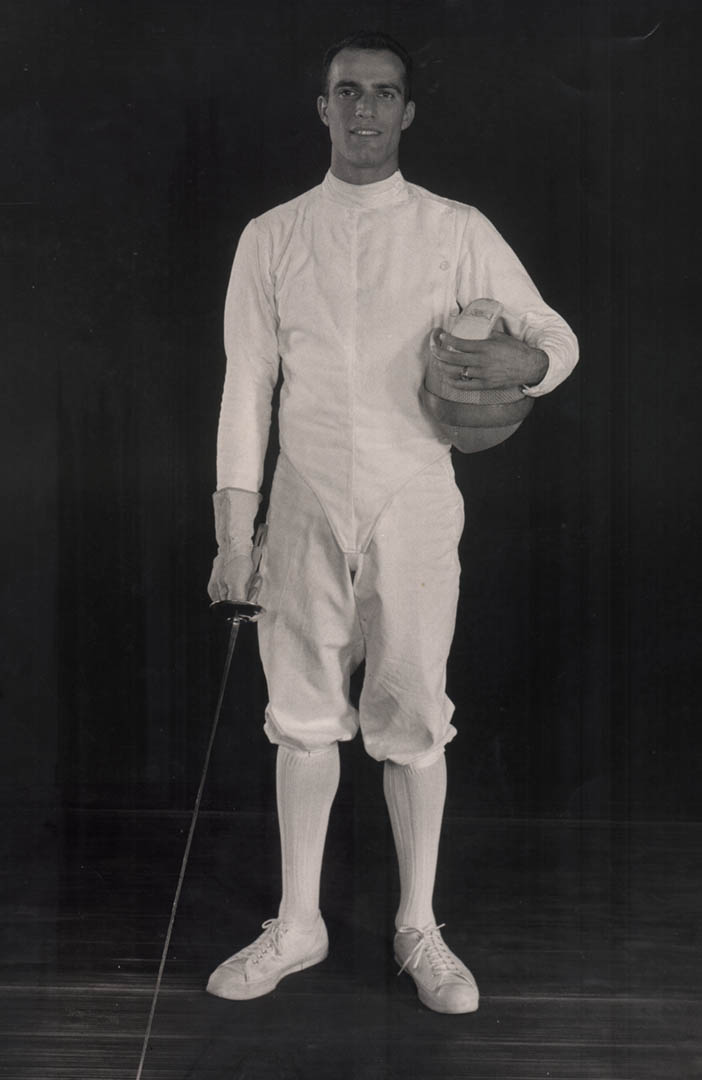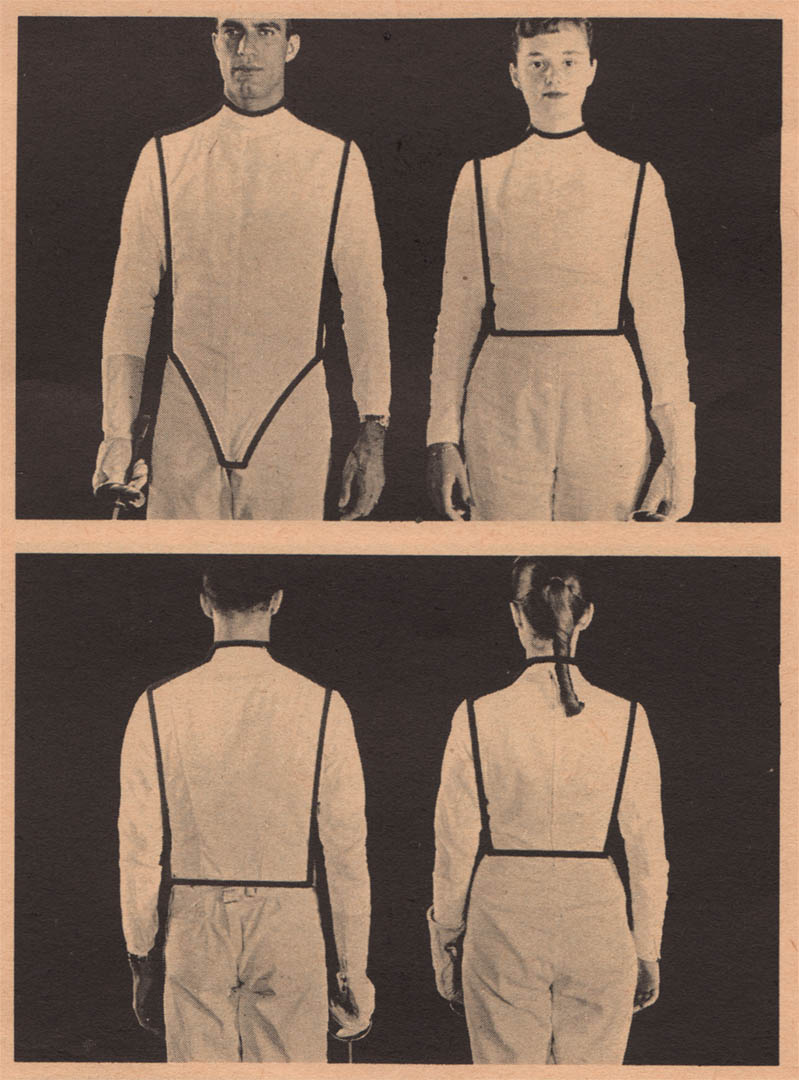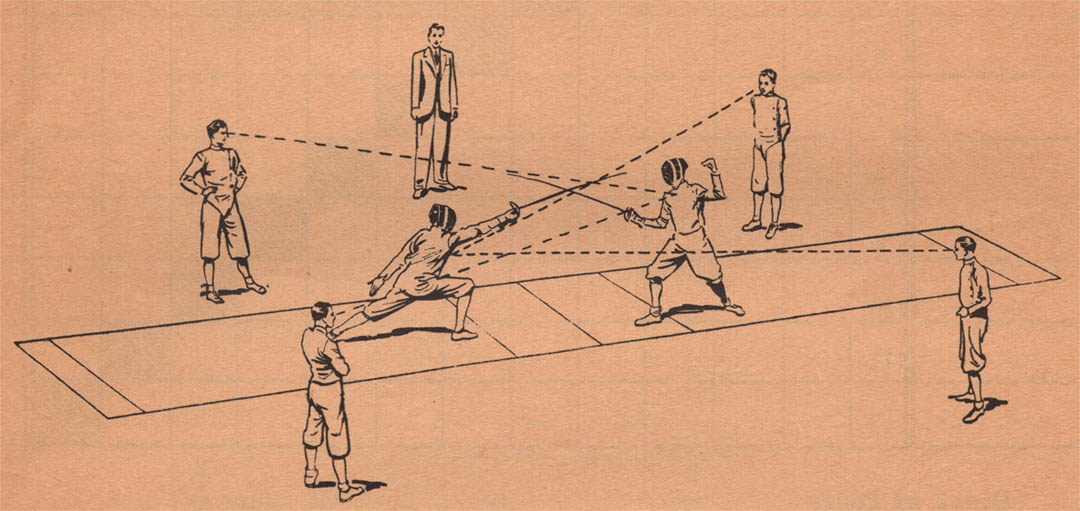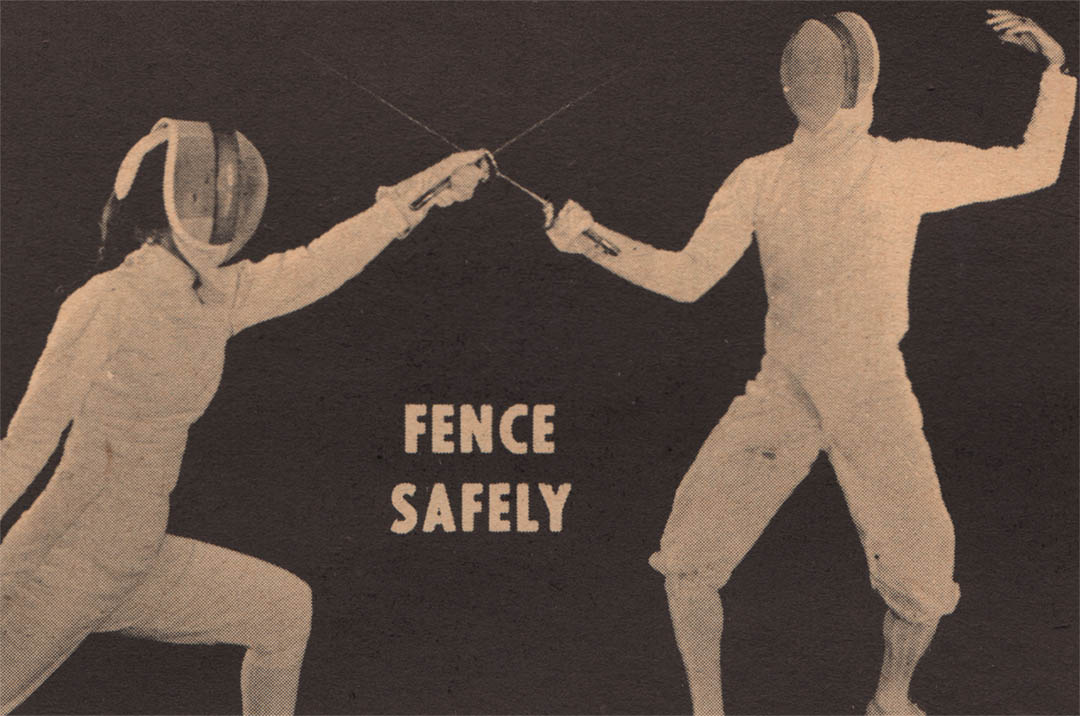It’s an interesting time for fencing coaches and clubs, as everyone tries to grapple with maintaining some level of instruction for their students during a global pandemic. The reach of technology in our lives today makes it easy to deliver, but that wasn’t always the case. If you’ve seen some earlier stories and videos on this site, you may have taken a look at what Charles Selberg used to combine a solid teaching methodology with film technology to create a teaching aide for classroom use. (See what I mean here.) Believe it or not, the technology Charlie used was, at the time, the cutting edge. Today we’ll go a step backwards.
The Fencing Instructor’s Guide to Fencing Instruction, circa 1960.
This booklet, checking in at 64 pages chock full of pictures and diagrams, was created by The Athletic Institute. They aren’t around anymore, but they published a lot of books on sports, many of them focusing on the theme of ‘How To Improve Your (pick a sport). In this booklet, they run through an entire instruction progression for basic fencing that was put together by long-time coach at the University of Illinois, Max Garret. Max wrote a couple of other fencing books and they were all of a similar theme and style. This work adheres pretty closely with what he published in 1961, a book entitled, not surprisingly, “Fencing”.
All the fencers who modeled for this handbook together. Anyone recognize anyone? I’ve a name to attach to the guy on the right. I’ll get to him in a bit.
One of the benefits, if I may, of being stuck in my office with nowhere to go for the last 6 weeks is that I’ve clawed my way through a whole backlog of work that has been sitting around and mocking me, some of it for quite a long time. In my head, it sounds like this:
…if you can picture boxes of books and videotapes, papers that need sorting and photos that need scanning coming together to form a body and voice. This would be it. (Stir crazy? Moi? Heavens no!)
And so it was that the subject of today’s story came from a stash of books that were donated to the Archive by the daughter of Ferenc Marki. I took a trip to Colorado awhile back to visit with Juli and she was kind enough to donate some amazing material related to her father’s decades-spanning and very successful fencing career. (That story is here.) One of the fun tasks – and that’s not sarcasm – I set for myself last week was tuning up and filling out my database for the Archive’s collection of fencing books. I’d already photographed most all of the book covers, but I needed to create individual entries for every book, including title, author, publication date and current location.
A snapshot of the Airtable db I’ve been filling out.
I probably could have used Excel or Google Sheets for this just as easily, but it had been so long since I’d played with any databases (where I was actually personally invested in the information) that I thought I’d give Airtable a try. It’s free, it’s all online and none of the information I’m putting in the cloud is of value to anyone but me, so hacked data isn’t much of a concern. 209 entries so far, and I know there are some more books at the club I forgot to take into account, so more work to do. Many duplicates. And the Fencing Instructor’s Guide from 1960 is part of the Ferenc Marki collection.
But this wasn’t just a book with writing and pictures, no. This was a multi-media presentation with moving parts requiring extra hands and plenty of space. This booklet was prepared to be used in conjunction with one of the greatest inventions of the middle part of the last century: the Slidefilm Projector with Record Player. Here’s a snapshot of one I pulled from the web:
This ingenious device was a staple of instruction in my youth. Walking into a classroom and seeing one of these set up was almost as thrilling as seeing a 16mm projector. Almost. Keep in mind, this was a long time ago.
This contraption projected images from a filmstrip roll of 35mm pictures. Slides, but not mounted. Printed on a continuous roll and meant to be projected one at a time. There was a handle that someone had to turn and it would step – click, click, click – through one image at a time. But wait! There’s more! The record player had the audio track of the instructional text and every time the monitor was to turn a slide, you’d hear a “beeeep!” If the monitor got sidetracked or slumped over into a coma, you’d get out of snyc with picture and sound. You had to stay frosty to make this work. If you really don’t understand my description, here’s a YouTube video of this system in action:
You, too, can earn a huge bagfull of money by investing in Magic Fingers at your local motel! Learn how!
Did you get through the whole thing? For god’s sake, why? That’s what multi-media instruction of this kind looked like. This particular example is from a “portable” device that included a screen. The example I included in the photo up above was meant to be projected on a larger screen.
The booklet was intended, naturally enough, to be used as a supplement to instruction. However, it was designed more for the novice fencing instructor in an attempt to overcome the lack of experience on the part of that teacher. At this point in time, in this big country, there weren’t that many accredited fencing masters, but fencing was well known enough that often schools would have a closet full of equipment but no one on staff with more than a passing amount of experience with the sport. So you take a sports coach, give them some audio-visual assistance and expect them to figure it out, right?
That’s a lot of dang words for a book that I promised was “chock full of pictures. The good thing about the above page is that it clearly is meant to instill the fear of deviation on the part of the instructor, regardless of the sport being taught. My favorite sentence is in Point #5: “Wise leadership will see to it that enthusiasm in game participation will not be allowed to destroy all adherence to correct performance of individual skills and team play.” Do it right or don’t do it at all!
Ok, so we’ve set the stage for this:
A photo example on the left, with the instructional text on the right. The text was played on the record and after every line of the instructional dialogue was heard, you’d hear the cue: “beeeeep!”
Ah, youth. A simpler time. The Sports Institute and Maxwell Garret put a lot of effort into creating this program and I’d so dearly love to have a copy of the filmstrip and accompanying record. There are many examples of different brands of projector/record player devices on Ebay at any given time, so it’s possible to recreate this experience for a new generation of fencers. It’s not as exciting as YouTube videos or live instruction on Zoom, but… well, it might help you get some nap time in. Full disclosure; watching these types of filmstrip presentations, with or without records (audiotape came into use late in the game), was almost always dreadfully boring. I speak from experience here. But what were the options? This is before home video. It’s even before Selberg’s jump to the next level of having filmed motion picture sequences, although his chosen technology eschewed the use of accompanying audio. These slides were static and the narration was almost always done in a dry, clinical fashion that seemed to have been done purposely to induce you to fall asleep. But that doesn’t mean the whole thing was without merit. These photos alone are classic examples of just how difficult it is to capture the essence of fencing instruction in a static image.
Imagine the scenario in which you are presented with this type of instruction. It was challenging, to say the least, to play these sorts of projected AV programs in a gym. Gymnasiums used for athletics have one particular thing that makes using this type of technology as an in-class aid difficult or impossible: light. To see the images, you need dark. Instead, from my reading a bit of the booklet, it was recommended that you show a section of the instruction in a classroom that you could make dark (“Kids! Nap time!”) and then proceed to the gym and attempt to put in practice what you were supposed to have absorbed of the lesson.
As perplexing as the image above appears at first glance, it’s actually a pretty solid attempt. The numbers confuse the issue to a great extent, but if you look close, you’ll see our left-hander has, from guard (1) lunged (2), recovered her back foot forward (3), and lunged again. Pretty sweet, but visually baffling as all get out.
This one captures the mid-point of the lunge in a fun way. I have the recollection that it’s been pretty effectively proven that, even though most of us from back in the day were taught that the lunge was kicked off from the heel as shown here, in fact, almost all fencers come off the toes of their front foot. Slo-mo replays pretty well established that as fact, didn’t it? Am I remembering that right?
If you recall the picture at the top and my mentioning that I could name one of our subjects, here goes:
I thought this guy looked familiar when I spotted him in this booklet, so I went back to look at the photos I scanned from Delmar Calvert’s collected memorabilia. Sure enough, not only the same guy, but I’m convinced the below was taken at the same photo shoot.
When Delmar was coaching in the midwest for a time, Larry Silverman, above, was one of his students. Larry won a couple of midwestern championships and made the semi’s at Nationals a couple of times in both foil and sabre.
It’s challenging to represent fencing actions in still photographs for instructional purposes. It always is. If you look at any book of fencing instruction that includes photos or illustrations of what you are meant to do, there’s almost always an aspect of the image that makes interpreting exactly how to emulate the action challenging. This is almost the entire problem presented to anyone that delves into the mystical realm of recreating 16th century rapier play based upon the illustrations from contemporaneous manuals, or any of the other styles of ancient swordplay depicted in various ways over the course of centuries in this or that ancient tome. It’s not easy to create in a still image, with any exactitude, something that completely and fully conveys all meaning for an action that is meant to be performed at speed with precision. It’s true whether you’re looking at Capo Ferro or trying to decide what advantage making smiley faces with the golf ball on the end of your foil provides.
When I first glanced at this one, I thought, wrongly, that the dark lines indicating the target area was actually marked on the jackets themselves. After looking more closely, I realized they’re only drawn over the top of the photos. And, yes, the above is the correct indicator for the difference between target areas for men vs women. Come to think of it, I’m not sure when this changed. Mid-1960s, I think.
That’s a lot of dotted lines to figure out. The good news is, with all the dotted line watching being done by the side judges, apparently the Director doesn’t need to look at anything. Or anything specific? How do you draw that? I guess you don’t. Speaking of Directors though, here’s a style of dress for officiating a fencing bout that needs to come back into fashion:
That’s Maxwell Garret in the referee outfit. And that’s what we call that position now in our sport. Referees. Once they were Directors. Now, Referees. There’s a story about when this change took place. Andy Shaw, the man behind the Museum of American Fencing, took it upon himself to show up to officiate at a National event dressed pretty much as you see Mr. Garret above, although I think Andy also added a whistle to his outfit. If I’m remembering correctly, it was the last time Andy was asked to officiate at a National event. No sense of humor, some people. And yet, here’s an example from 1960 of a highly respected and successful coach showing exactly that style of dress as being appropriate to our sport, even if he is without the whistle. Precedent! I vote for Referee outfits! Come on! Who’s with me?
Well, far be it from me to demand one style over another. Still and all, we should be right thankful in this pandemical time that we have access to modes of technology far advanced beyond the available tools of 1960. It’s easy to forget the tech that has long-since been surpassed by far superior innovations that can much more effectively aid in the classroom, or while sitting in front of a computer screen. I believe this; not only has the means to deliver information increased exponentially, but our ability to assimilate information has increased proportionally. I don’t want to write a thesis on it, though. When I imagine myself as a third-grade student in class, I’m sure we could have taken in data at a much higher rate than was offered by slidefilm projection instruction, record player or no. But that was what it was. Still, it’s quite true that the appearance of a 16mm projector was a much more welcome sight.
I’ll just leave you with this final image that clearly encapsulates the best of advice that can be given in our sport. It was true back in the day and it’s just as true now. So don’t forget.


